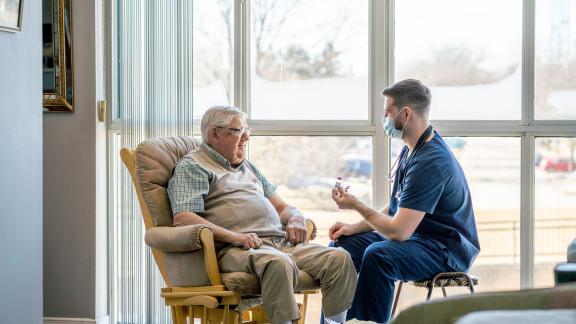Warning NHS waiting list could be scratching the surface

The NHS in England could face a hidden waiting list of nearly six million people who have not come forward or been referred for treatment yet due to the significant disruption brought about by the pandemic.
Following the failure of the Budget to invest appropriately in the NHS, urgent action is needed to support the sector, including to manage the treatment backlog in a realistic, fair and safe way.
This should support different parts of the NHS, including primary care, to work together to decide what is best for their local communities rather than individual services being assessed on standards that will be impossible to deliver because of the pandemic and within current resources. Also, it should consider the emotion and energy sapping pressures that health and care workers have been through and continue to face.
The NHS Confederation wrote to the Prime Minister last month about these and other issues and is now calling for a comprehensive plan to help ensure people can get the treatment they need.
Despite the NHS performing more than six million elective treatments in 2020 and while its hospitals cared for nearly a quarter of a million people with coronavirus, the treatment backlog for non-urgent procedures stood at 4.52 million by the end of last year. This came as services and wards had to be repurposed and staff had to be diverted to support the immediate demands of the virus, while productivity was also set back by vacancies, sickness absences and the need to comply with the necessary social distancing and infection control measures.
Of the 4.52 million people on the waiting list in England, around 224,000 had been waiting over a year for their treatment, compared to fewer than 1,500 people at the end of 2019.
New analysis commissioned by the NHS Confederation out today (Sunday 7 March) suggests that the true demand for elective care could be much larger when referrals for treatment, such as from GPs, begin to increase again, following a 30 percent drop last year.
It says that 5.9 million fewer referrals for elective treatment were made in 2020 compared to 2019 (14.25 million compared to 20.18 million). The difference is believed to be due to the disruption of the pandemic and the public not coming forward despite the NHS being ‘open for business’.
The exact size of this hidden list is not known currently as some people may have sought care elsewhere, while others may never come forward. However, if a sizeable majority did present, it could significantly add to the total. One of the modelling projections in the analysis suggests the backlog could therefore reach 6.9 million by the end of 2021.
Although the NHS has prioritised urgent and emergency procedures, this still means that a significant proportion of people at higher risk are being supported by primary and community care when these services are already stretched; for example, due to their vital roles in supporting the growing list of people with ‘Long Covid’, the growing demand for mental health support and in delivering the mass coronavirus vaccination programme.
Orthopaedics and ophthalmology referrals saw the greatest reductions in the last year, which are clinical areas with conditions that could steadily worsen if left untreated.
With the national lockdown in England beginning to ease in the coming weeks and the threat of coronavirus still present, the NHS Confederation is calling on the government to be honest with the public about the scale of the challenge facing the NHS, to work with local leaders to agree manageable plans, and to give the services the resources they need to respond to what will be serious and long-term problems.
Danny Mortimer, chief executive of the NHS Confederation, said: “The NHS has worked tirelessly to support the country in response to the pandemic and while it has never been a Covid-only service, the disruption has been enormous, leading to a considerable number of people waiting far longer for treatment than the NHS would ever want.
“Health leaders are concerned that we may be scratching the surface of this waiting list if further referrals come through at a time when coronavirus pressures are still high, the workforce is in a very fragile state, and when capacity is still so constrained.
“For their part NHS organisations are making substantial changes to how they work to improve access and maximise the capacity that is available to them. They are working together to organise treatment between different organisations and they are applying best practice at a scale and pace that have not been seen before. But this will not be enough to address the problems our patients face.
“It was therefore something of a shock that the Chancellor did not even start to remedy this in the Budget. The Government now needs to level with the public on the scale of the challenge facing the NHS and step up with a strategy that will work with all parts of the service to tackle the waiting list in a safe, fair and patient-focused way.
“As we have made clear to the Prime Minister, we need similar support to address the impact of increased demand for mental health services and the care of patients with Long Covid in our communities. Also, we need urgent action to address under investment in our infrastructure, workforce and the health of the population, which has been lacking for far too long. Our colleagues in social care face even greater challenges and have experienced an even weaker response.
“Despite everything the NHS is doing, without a comprehensive new plan, the government faces the politically unacceptable legacy of hundreds of thousands of patients left with deteriorating conditions for the remainder of the parliament.”
In its briefing, the NHS Confederation sets out what a new framework for delivering elective care could look like and the issues it will need to consider. This includes increasing capacity and capital, exploring ways to manage the backlog between trusts and by involving community and primary care services, providing more support so that people can ‘wait well’, and rethinking how lists are measured.
This follows the NHS Confederation writing to the Prime Minister last month to call for a steady approach to recovering patient services, which protects health and care staff from burning out after the extreme and sustained pressures of the pandemic.



